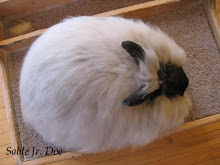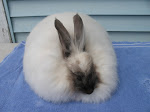--another post from the old blog!
Well, I was happily taking pictures of my babies at 9 weeks when my camera batteries suddenly went dead, and the absence of a spare set forced me to stop what I was doing and put the batteries into the recharger til tomorrow:(. Well, that works out alright since I can just post them tomorrow instead---but as I was grooming and checking out coats and texture on the babies and some of the adults today, I noticed a few extra things about wool that I thought I would brainstorm with tonight:).
Lately I've been in the habit of grooming out my babies, plopping them onto the grooming table, and then standing back to look at them from zillions of different angles:). First of all I look hard at the profile (which is probably the best angle to check for balance), and then I check them from the front and then from the TOP, in a kind of aerial view. When looking at the profile the thing I am mainly checking for is balance. Now, good balance means that no part of the rabbit is out of sync with any other part. No part is too high, or too low, or too flat, and no part sticks out abnormally far in any direction (if that makes sense:)). A rabbit with excellent balance looks good any way it sits from pretty much any angle, but a rabbit that lacks balance looks awkward, and when you look at it you find yourself wishing that it had more height, depth, roundness, etc. etc. etc, making the concept a very difficult thing to define. The longer I am in rabbits the more I realize that MUCH of what we look for in a good one is hard to explain and put our finger on, but as is so often said about anything exceptional, you'll know it when we see it:).
Next, I try to examine the rabbit head on to determine ear carriage, headset, and the 'evenness' of the coat from the front. The FA is widely known for it's distinctive 'oval' shape, but what we don't realize at first is that it is oval from the front of the animal as well. A good coat should present even density all around the head and back, and the hem of the dewlap should be perfectly even so as not to break up the baseline of the coat. Ear carriage and headset are not critically important in angoras, but I like to see that they are still in balance with the rest of the animal and the head snuggles back into a 'pillow' of wool behind the face.
Today I just had two baby REW does out (which I'll post pictures of tomorrow), and while both were perfectly equal in terms of type, one had a distinctly silkier coat than the other, which had the type of textured coat that you would usually expect to find on an adult. Interestingly, there was no real difference in density between the two rabbits because the same amount of of underwool was present on both, but there was certainly a difference in the shape of the animal, which could clearly be seen by viewing the coat from above.
In FA coats (and probably all angoras to different extents), everything seems to come down to this: there are two types of 'hair' in a French Angora coat, and each has a specific and unique function. The underwool, which is CRITICAL for density in the angora breeds, is a 'crimped' type of wool with tiny zigzags present in each shaft of hair from the skin level to the tips. These 'zigzags' are what give strength to the wool, meaning that their shape enables them to support a heavy coat from underneath. The zigzags in underwool also provide Compression (like springs), so that when you grab a fistful of healthy prime wool in your hand and let it go, it 'springs' back rather than falls limply out of your hand. An excellent coat with a BALANCE of guard hair and underwool should be completely self supporting in an FA. It should stand out evenly all around the animal and give it life and density, while a 'bad' coat will look flat and limp because there is no crimp or 'strength' to support the hair from underneath and give it loft.
Guard hair has a completely opposite function in a wool coat----it provides Shape and Finish. When I looked at these two little does today I realized that while both had equal amounts of density, the one with the textured coat had a beautiful, uniform shape which remained the same no matter how she sat or moved. The baby with the silkier coat had an oval shape too, but it was not as defined as the other one's, and it was more likely to alter it's shape as it moved around. Time would prove the difference here, but if I had to guess I would say that the silkier baby is going to have a harder time holding it's coat in the future. She may not be able to hold it as long, and when it starts to slip it will probably look disheveled and much 'messier', shortening her time on the showtable and making the quality of the wool decline more rapidly. It is very clear to me today that what I am shooting for is a perfect ratio of guard hair to underwool to provide balance and density, but I am ALSO looking for the proper TEXTURE, because that is the quality that ropes in density and gives it the shape, form, and longevity that a good FA coat needs.
I think the next thing I will check out is what happens to the crimp when the coat gets old and starts to molt. If my observation about the zigzags holds up, the underwool should gradually lengthen, relax, and straighten, which would explain why the compression of an old coat decreases (or we get 'lack of life to the wool', as a judge would say), and we find that the coat as a whole gets flatter with the straightening and begins to lose it's shape before it actually releases.
In conclusion, I guess we could say that an excellent prime coat with lots of density HAS to have nice, tight, crimp from the skin to the tips, while a molting coat or a coat without density will be lax, fairly straight, and in some cases lack crimp entirely when you blow into the wool. When choosing your keepers it is important to feel the wool but also look at it, and never hold onto anything that does not show evidence of the critical supporting underwool and textured guard hair that make an outstanding FA coat !
Sunday, July 19, 2009
Subscribe to:
Post Comments (Atom)























No comments:
Post a Comment